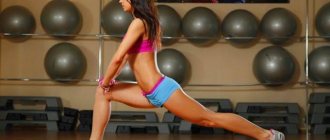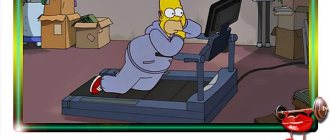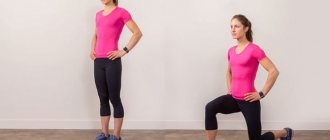Hello everyone from big to small. My name is Vitaly Okhrimenko, and today I have a great desire to write a good article about how to properly stretch in the gym.
I have already written about the benefits of warming up, listed exercises for warming up before training, and wrote a short article about how to warm up your muscles. And today, in order to logically continue this topic, I consider it my duty to write about stretching in the gym, which is correctly called stretching. Although, to be honest, I don’t understand why bother? Stretching is a more understandable word for all of us.
.
Classically, stretching is done before and after training. Today I will describe the pros and cons of each of these stretch marks and together we will draw conclusions: which stretch do we need and which one is in the firebox. But without exercises, this article would be empty, so I advise you to definitely study stretching exercises.[contents]
What kind of stretch do we need?
In general, there are several types of stretching: dynamic, static, active, passive, ballistic and God knows what else. But we will not study them all today, because we are only interested in one type - static stretching, when the muscles are stretched to a certain point (the point of maximum stretching) and held in this position for some time. Today I will try to answer as fully as possible the questions of when and how to stretch and whether it is useful to stretch at all.
It is common to see a non-literate male or female athlete doing dynamic stretching after a workout. That is, instead of freezing at the point of tension of the muscle and doing the actual stretching, they tighten the muscle and make some kind of rocking or rough tugging movements. This is extremely wrong, because dynamic stretching with jerking exercises is harmful to the muscles.
Since muscles receive a huge number of microtraumas during training, dynamic stretching simply worsens their condition. As a result, the dynamics of recovery worsen and the muscle takes a long time to heal, therefore it begins to grow later, and not earlier as we need it.
Warm-up at home: types of exercises
Warming up before training at home, a video for women of which will help you understand more about it, should be comprehensive. As already mentioned, it includes three components. Let's consider them p>
General warm-up
Warm-up exercises before training at home for girls can be divided into groups:
- Universal. They can be used before any type of physical activity. Such exercises are general complexes that are familiar to us from school. This can be turns and tilts of the head, and after them - working on the shoulders, arms, body, hips, shins, and ankles. You can complete this with breathing exercises. You can watch a video of a full body warm-up at home to learn more about it.
- Special. The difference between them is that they are aimed at maximally warming up the specific muscle groups that you are going to work. If we are talking about strength training, then exercises from the standard complex can be performed, but without the use of additional weights.
You can use the same running, jumping rope, fast walking, going up and down the stairs. A good warm-up for the abs is spinning a hoop. If you plan to run, you can do lunges, squats, bends, and push-ups. Stretch your thighs and calves. Rotation of the knee joints and ankles is also important.

Warm up the joints
A video warm-up before training at home, aimed at the joints, helps improve their mobility and coordination. Such a complex can be quite effective, and even replace a full-fledged workout. It is recommended to perform it both before cardio training and before strength exercises, fitness, yoga, and so on. In this case, the complex may consist of the following exercises:
- Tilt your head to the sides and forward and back, rotate your head.
- Tilts the body to the sides.
- Stretch your arms to the sides and...
- Rotations of the hands, chest, shoulders and forearms.
- Pelvic rotations, body twists, leg rotations.
- Raising the legs, bending and extending them at the knees.
- Rotation of the ankle joints.
- Calf raises.
Warm-up
To lose weight and/or improve your body shape, you need to approach this issue comprehensively. Not the least place in this case is given to stretching. It is often recommended as a cool-down after a workout, but before physical activity it will not be superfluous. It is recommended to perform exercises with a certain amplitude.
The better the muscle tissue is warmed up and stretched, the lower the risk of injury.
It is recommended to do stretching after a mini-set of warm-up movements. Everything needs to be done smoothly and carefully, avoiding pain. You should feel comfortable. If the stretching was done correctly, a pleasant feeling of warmth should spread throughout the body. Stretching is especially important for those who want to do the splits. When the muscles warm up a little, you can begin a dynamic warm-up. Warm-up exercises before training at home for girls can be as follows:
- As a basis, you can take exercises aimed at general warming up. When performing them, try to linger for a while at the top point and stretch the muscles as much as possible.
- If necessary, help yourself with your hands, but try to avoid jerking. Please note that when practicing on your own, you may have difficulty assessing the correctness of your body position and your progress. If possible, do exercises in front of a mirror. This will give you the opportunity to see your main mistakes and, if necessary, correct them immediately.
- Exercises such as swings, rotations with legs and arms, and various lunges are good for warming up. Please note that the amplitude should initially be small and increase over time.
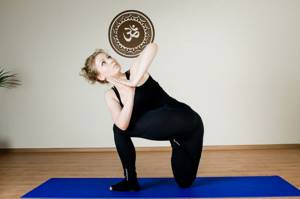
Who needs stretching
Some athletes, out of their own stupidity, believe that stretching is for girls. That a real man should only carry a barbell or hit himself in the ring. But no, it’s not like that. Stretching is necessary for everyone who works out in the gym, no matter if you are a guy or a girl.
Just for fun, you can find a full workout of some professional bodybuilder on YouTube. At the end of the workout, all professionals spend at least 5 minutes stretching. “Well, they are professionals, but what kind of stretching do I need?” - you say. This argument is not an argument at all, because there are quite compelling arguments for stretching in the gym. First I will give reasons, and then I will tell you how to do a good stretch.
Stretching set before and after training
Standing biceps stretch
- 10-15 seconds
- Body Part: Biceps Equipment: No
Standing triceps stretch
- 10-15 seconds
- Body part: Shoulders Equipment: Body weight
Delt stretching
- 10-15 seconds
- Body part: Shoulders Equipment: Body weight
Stretch the neck muscles to the sides
- 10-15 seconds
- Body Part: Neck Equipment: No
Sitting stretch
- 10-15 seconds
- Body Part: Lower Back Equipment: No
Stretching the calf muscles using an elastic band (foot turned inward)
- 10-15 seconds
- Body part: Calves Equipment: Other
Quadriceps stretch while lying on your side
- 10-15 seconds
- Body part: Quadriceps Equipment: Body weight
Add to Calendar * Add to My Workouts * Print Workout
* — The service is in beta testing
Ultimately, the effectiveness of stretching depends on which groups you emphasized in your training.
Why do you need stretching?
Why do you need stretching and how to stretch correctly? I think this question is asked by many, both beginners and active bodybuilders. After all, it would seem: we are pumping a muscle, doing fitness, and God bless him. Yeah my friend, no matter how it is.
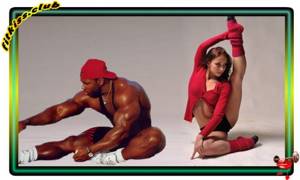
Athletes often wonder when to stretch before or after training. My answer is: stretching before a workout and after a workout have fundamentally different goals.
Why do you need to stretch before training?
Stretching before exercise helps your muscles gain a sufficient level of flexibility, which will have a positive effect on your range of motion. Physiologists have long proven that the higher the amplitude of movement in bodybuilding, the more effective the exercise. In addition, stretching before training helps warm up the muscles. It is advisable to do stretching at the beginning of a workout, but after a workout it is MANDATORY !
Why do you need to stretch after a workout?
The main purpose of stretching after exercise is to return the muscle to its former length.
Every time we perform a bodybuilding exercise, we seem to contract the muscle, shortening its length. It takes some time for the muscle to regain its previous length (usually about a couple of days). Only after this period does the growth of this muscle begin. In fact, returning the length of muscle tissue can be safely called the main condition for recovery. By stretching after training we increase the speed of recovery. But this is not the whole answer to the question why muscle stretching is needed.

When we work out in the gym more often than once every 3 days, our muscles do not always have time to restore their length. For our body, it’s like putting on shoes that are 2 sizes too small – a terrible inconvenience. Joints and ligaments are forced to adapt to the shorter muscle, which causes not only stiffness of movement, but also various types of joint injuries, inflammation and other troubles.
By lengthening a muscle by stretching, we not only relax it, but also return our tissues and joints to their former comfort. In addition, by stretching a muscle after training, we relax it, relax our body, our brain from training. But that's not all.
Scientists have proven that stretching after working out in the gym removes lactic acid from the muscle, and as a result, the pain that often appears in the trained muscle the next day will be much less. That's it!
And how effectively will a muscle contract after, say, three years of intense training without stretching? After all, by increasing its density, a muscle loses length, and when will there be nothing left to lose? There have often been cases in the history of bodybuilding when stretching helped athletes overcome muscle congestion. So the main argument why we need stretching after strength training is to help our muscles become bigger and more defined! For example, let's look at two biceps, one of which is regularly stretched after training, and the other is not.
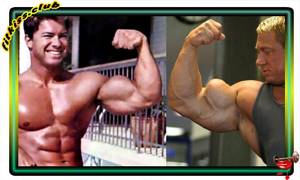
Or let's look at the pectoral muscles of Arnold Schwarzenegger and other champions. Do you think Arnie pulled his muscles after his chest workout?

Other exercises and recommendations
Warm-up should be done at a gentle, measured pace so that the body is prepared for training, but not tired. The movements should be performed dynamically and smoothly, so that discomfort and pain will not arise.
It is advisable to warm up in warm, dry rooms or outside in good weather. While performing exercises, it is necessary to monitor your pulse and body temperature. After feeling warm in the body and a surge of strength, you can safely begin basic sports activities.
Recommended warm-up exercises:
- Perform head tilts: forward, backward, left, right.
- Rotate your shoulders, lift them up and down.
- Tilt your torso to the left, to the right.
- Perform push-ups from the floor.
- Run in place with your knees raised.
- Squeeze and unclench your hands, then perform rotational movements.
- In a lying position, raise your legs up and pedal an imaginary bicycle.
- Perform rotational movements with your feet.
- Lie on your back, lift your legs one by one and pull your arms to your chest.
- Perform a “bridge” stance, with your arms straight and legs bent.
It is very important to warm up before training. Thanks to it, all muscle groups, ligaments, tendons warm up and joint mobility improves. Training becomes better and more effective.
Lack of warm-up leads to injuries and sprains during major sports activities. It is useful to perform dynamic or static muscle stretching. They differ in execution technique and have their own characteristics that must be taken into account.
Benefits of stretching in the gym
- An increase in muscle mass through muscle stretching. That is, the longer the muscle tissue, the more room for its growth and, accordingly, the greater the potential for muscle growth.
- Improving the flexibility of muscles and joints - the more flexibility we have, the easier it is for us to learn the secrets of bodybuilding. In addition, flexibility allows you to use a larger range of motion in some exercises. And scientists proved a long time ago that the higher the amplitude of movement of an exercise, the more effective it is.
- Acceleration of regeneration of damaged tissues. Thanks to stretching, muscles heal faster and therefore grow faster.
- Increased blood circulation to muscles. Due to the fact that the muscles receive more blood, their growth is possible faster, and in this way there is more oxygen in the muscle.
- A stretched muscle contracts better, which means it has the potential to become larger.
Warm-up steps
When performing a warm-up, it is important not to overdo it so that it does not turn into a full-fledged aerobic workout. Warm-up exercises should be selected taking into account the physiological characteristics of your body and the nature of the upcoming workout
Warm-up exercises should be selected taking into account the physiological characteristics of your body and the nature of the upcoming workout.
Proper warm-up before training includes the following steps:
- general;
- special;
- stretching.
Sometimes there are four stages: along with a special warm-up, they also include warming up the joints, although usually they are successfully combined. It is best to warm up the joints with swinging and rotating movements, squats, etc.
Article on the topic: “What is creatine for?”
A general warm-up is designed to warm up the entire body, which speeds up metabolism and improves body tone. This increases blood flow and blood supply to the muscles.
The pulse rate gradually increases to 120-140 beats/min. This point is especially important, since sudden physical activity is extremely harmful to the heart.
For a general warm-up, 3-5 minutes is enough. Typically it includes light running in place/on a treadmill, jumping rope or in place (can be replaced with an exercise bike) and squats.
httpv://www.youtube.com/watch?v=embed/BVEWh2EczLc
A special warm-up is aimed at preparing the body for the training program. So, before strength training, for example, squats with a barbell, you should squat without load, only with your own weight, to warm up your knee joints and stretch your quadriceps.
Article on the topic: “How to take Tribulus”
It doesn't hurt to vigorously warm up your legs, arms, pectoral muscles and back muscles. In addition, such a light workout will help determine your readiness for training: if you notice any discomfort, for example, pain in the knee, then this is a reason to refuse to lift heavy weights.
httpv://www.youtube.com/watch?v=embed/M410PQj9Fbg
Stretching promotes the elasticity of muscle fibers and ligaments and increases joint mobility. Stretching as an element of the warm-up must necessarily follow the warm-up, otherwise injuries are possible. Stretching is divided into:
- static, when the stretched muscle is fixed in this position for at least 30 seconds;
- dynamic, when the tense muscle makes small short-term movements (for example, when stretching the leg at the hip joint, the leg sways, but without swinging);
- ballistic, which most experts do not approve of because of the risky overloads during sudden sweeping movements. Used primarily in Japanese martial arts.
Article on the topic: “Arachidonic acid”
httpv://www.youtube.com/watch?v=embed/OVinUl49JE8
So, you have a general idea of the need for warm-up and its types. It should be recalled that the warm-up program for girls is softer.
To properly understand how to warm up, use photo and video materials, including those from the Internet, then warming up before training will help you achieve better results.
The best sports nutrition for weight gain
httpv://www.youtube.com/watch?v=embed/0qhvu59LkW0
Stretching before training in the gym
In combination with a full warm-up, stretching before training helps the muscles prepare for training and prevents a variety of training injuries. But how to properly stretch muscles before training?
Pre-workout stretches are gentle, shallow, and short exercises to stretch your legs, back, arms, shoulders, and chest. In fact, it is enough to spend only 3 minutes before training for normal stretching. The trick to stretching before training is that as a result of it, the possibility of getting injured decreases significantly.
What are the types and techniques of execution?
There are several types of muscle stretching before training at home. Each of them has its own characteristics and individual execution technique.
Dynamic
This type of stretching is very effective. It is performed while moving in a constant mode and at a certain speed. Each exercise must be repeated 5-7 times, the delay between approaches should not exceed 5 seconds.
During the process of dynamic stretching, the body quickly heats up, muscles tense, joint mobility improves , all this leads to an increase in the body's performance during training. When performing dynamic movements, the body's flexibility increases and the risk of injury decreases.
Several dynamic muscle stretching exercises for girls and men:
- Circular rotations with hands. Stand up straight, spread your upper limbs to the sides. Rotate your hands alternately, first clockwise, then in the opposite direction. Perform the exercise at a moderate pace, breathing through your nose.
- Swing your legs. Extend your left arm parallel to the floor. Swing your right foot, touching your palm with your toe. Repeat the same steps with your right arm and left leg. Perform several approaches.
- Squats with jumps. Place your feet shoulder-width apart and perform a normal squat. Jump up, while your body and legs should straighten. Land and sit down again. Repeat the exercise 7 times.
- Rotation of the pelvis. Make circular movements with your pelvis clockwise, then counterclockwise. The execution speed is moderate.
- " Mill". Spread your legs wide. Bend over and touch the toe of your right foot with the fingers of your left hand. In this case, the right hand should take a position perpendicular to the floor. Repeat the same with the other leg and arm. The exercise should imitate the spinning blades of a mill. It needs to be done at a fast pace.
If you hear cracking joints during dynamic stretching, you should not stop. Exercises must be performed until the sound disappears.
Static
When performing static stretching, do not make sudden movements. One fixed position is selected, in which you need to stay for some time. At this moment, the muscles and ligaments gradually stretch, become elastic and strong.
The duration of the exercise should not exceed 30 seconds. Before classes, it is recommended to warm up a little: do squats, bends, run in place, jump rope.

Static stretching exercises:
- Bend forward. Sit on the floor and straighten your legs. Lean forward, clasping your feet with your hands. Hold the position for 30 seconds. Rise slowly and smoothly.
- Leg stretching. Place your foot on a chair or bench. Stretch your foot and freeze for 0.5 minutes. Repeat the steps with the other leg.
- Hamstring stretch. In a standing position, connect your legs. Lean forward and clasp your knees with your hands. Stand like this for a few seconds, stretching the muscles.
- Back stretch. Lie on your stomach, stretch out your legs and arms. Raise your head and four limbs at the same time, stretch and try to fix the position for a few seconds.
- Stretching the muscles and ligaments of the shoulder. Place your left hand around your neck. The right hand should be on the elbow and press lightly on it. Hold for 30 seconds and do the same with the other hand.
Static stretching is done only at a slow, measured pace. Breathing should be even and calm.
Stretching after a workout in the gym
It’s funny, but I’ve never even heard the question: “Is it possible to stretch after strength training?” I’ll be honest – seeing someone doing stretches after a workout in the gym is almost unrealistic. This is the same wonder as seeing your grandfather dancing to hip-hop.
The trick is that the vast majority of us value our time too dearly. And if most of the time is spent on pumping, why spend it on some kind of stretching after training. This, by the way, also applies to stretching before training and warm-up and cool-down. In short, all that is preparation. And this, by the way, is a strong foundation on which every centimeter of our muscles is built. So it turns out that because of the fear of losing 5 minutes of precious time, we do not complete the foundation. But in vain, because stretching after a workout is very, very useful.
The key point is that after training, the body keeps the muscles tense for some time, and suddenly it has to enter into battle again. And stretching seems to be a signal to our CNS (central nervous system) that the muscles have already worked and now they need to rest.
Benefits of post-workout stretching:
- Muscle relaxation after training - muscles quickly enter the recovery process and, as a result, recover faster, which means they have more time to grow.
- Relief of the general condition of the body after the received loads.
- Increasing the elasticity of muscle tissue, and the more elastic the muscles, the stronger they are.
- Uniform distribution of tone throughout the muscles, which helps the figure to be more proportional.
- Fighting soreness (muscle pain the day after training).
- Acceleration of the metabolic process, thanks to warming up, muscles grow faster.
They say that yoga helps to improve strength indicators. Just 4 hours a month (1 hour a week) of yoga helps athletes achieve better results. I won’t subscribe to this statement; I haven’t experienced it myself yet. But as soon as you have more time in your life, you will need to check it out.
How to properly stretch after strength training
- No sudden movements or strong pressure on the stretch, no need to make rocking movements. Stretching is done with the same dynamics: one speed and one pressure force. Smoothly and gently fix the body in the desired position and stretch the desired muscle.
- Stretching should be pleasant and not cause discomfort. In fact, it should be somewhere on the line between comfort and discomfort.
- Smooth and measured breathing
- If you suddenly feel pain in a stretched muscle, you need to stop stretching immediately.
- Tips for Stretching
- No sudden movements, slow and steady.
- Slow and deep breathing.
- Completely relaxed body.
- There is no need to drink water before stretching.
- You need to start stretching immediately after training, while the muscles are well warmed up.
Warm up for optimal results
This is not only a precautionary measure, it also has positive long-term effects. A good warm-up routine will prevent injury and increase weight gain by warming up your strength and concentration.
An important element is monitoring your heart rate. Try to work in the first pulse zone and select warm-up exercises before the main workout in such a way that they do not overload your body and it does not become acidic ahead of time. Monitor your heart rate using the heart rate monitor on your arm. In this case, it is necessary to select light physical complexes, and the heart rate should be from 50 to 65% of the maximum.

Performing a warm-up routine will help develop the entire body as a whole and the functioning of the heart. The optimal warm-up duration is from 10 to 20 minutes. For strength training, when performing the FIRST exercise on a specific muscle group, it can consist of three stages:
First stage
The first thing you need to concentrate on during the warm-up is to pump up your muscles a little. The best way to do this is to perform 1-2 sets of 8-12 repetitions with a very light weight.
Feelings: at first you will be a little uncomfortable, there is a feeling of weakness. After the second set you begin to feel stronger.
Second phase
The next step is to prepare the muscles to lift heavy weights to failure. The next two sets should be performed with a load very close to what you will use in the first working set. Do only 1-2 repetitions, you will not tire your muscles and will not provoke microtrauma.
Feelings: It’s already hard for you, but it’s just a mental block that you will overcome. This is why warming up with weights is useful. The last approach is more difficult to perform, but you will begin to feel more confident.

Third stage
It is a mistake to believe that the next step in the warm-up is the transition to working approaches. After a hard warm-up, you should definitely rest for 2-3 minutes. This will reduce fatigue, and at the same time blood flow will remain at the same level.
Feelings: after the previous warm-up sets, you will perform this set confidently.
Next steps
You don't repeat the pre-workout warm-up exercises, but simply continue doing strength sets (most lifters do 2-4 sets of each exercise).
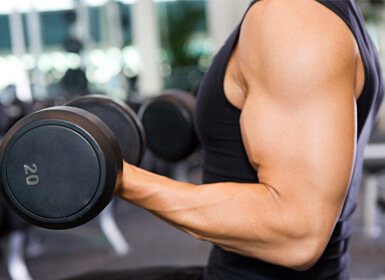
After warming up for one muscle group, you do not need to repeat the warm-up for that group throughout the entire gym session. For example, if you plan to deadlift, a light set of 8 reps with 40-60% of the lifting weight is sufficient as a warm-up.
How often to stretch
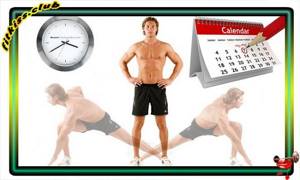
Is it possible to stretch every day or is it enough or how many times a week should you stretch? I briefly answered these questions above, but now I’ll summarize. Stretching can be done often, even every day. At least 1 time during 1 training session (preferably after training). However, if you want to dedicate 1 more day a week to stretching, kudos to you!
Is it possible to stretch during menstruation?
It would be right to consider whether it is possible to play sports at all during menstruation. I’ll have to remember to write a separate article on this topic sometime.
Doctors have found that girls who regularly engage in physical exercise are better able to cope with menstrual syndrome. But don’t confuse physical education and weight training. You can do it, but be careful. And you can do stretching, but also without fanaticism. After all, Olympic stars perform on any day; competitions are not adjusted to anyone’s menstrual cycle. So you can and should do stretching during your period, but without fanaticism.
Well, that's almost all. The theoretical part has been sorted out, we already practically know why and how to stretch, all that remains is to analyze the stretching exercises. And in order not to make the page immense, I will do this next time.
And that's all I have for today. I wish everyone strong and elastic muscles! See you soon on the pages of FitKis Club!
Vitakha Okhrimenko was on the line !
How to properly complete a workout?
To achieve the maximum effect from working in the gym, you need to know everything about how to warm up not only before completing the main set of tasks, but also after it. A cool-down will help in this matter - a post-workout set of exercises that will help the body calm down and realize that all the work with the exercise equipment planned for today has been completed.
It will take no more than 10 minutes to complete; acceptable exercises here include slow running or walking at an average pace; you can also use slow stretches in different directions. With a cool-down, your body can quickly rid your muscles of lactic acid, calm your heart rate, and normalize muscle blood flow.
Some athletes believe that they can do without a cool-down, but this is far from true. If you stop training suddenly, blood will begin to accumulate in the intramuscular veins, which will lead to a surge in pressure. The heart will be forced to increase the pace of its work in order to pass through itself the required amount of stagnant blood and to normalize the blood flow of the muscles, which is not at all beneficial for it.

